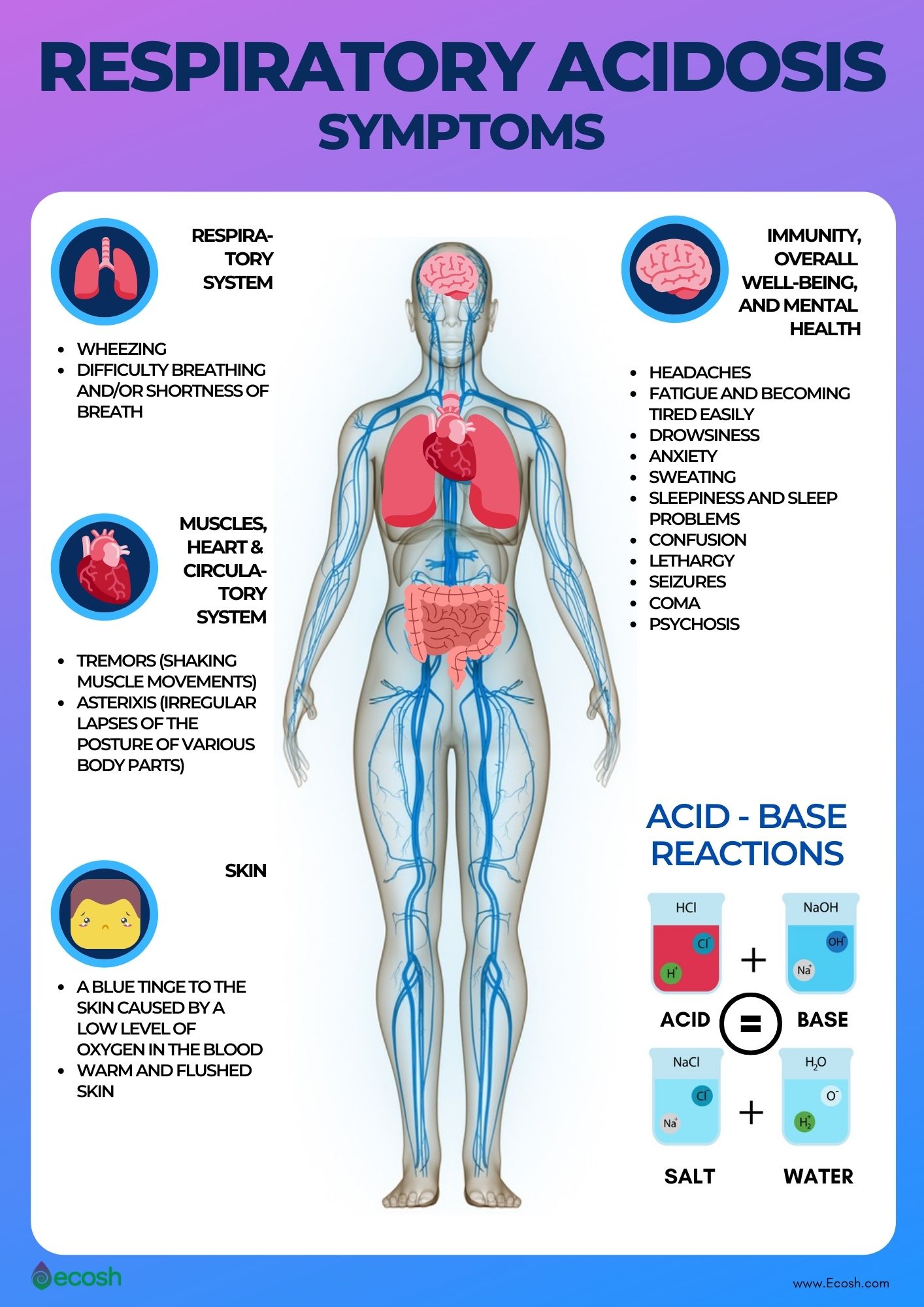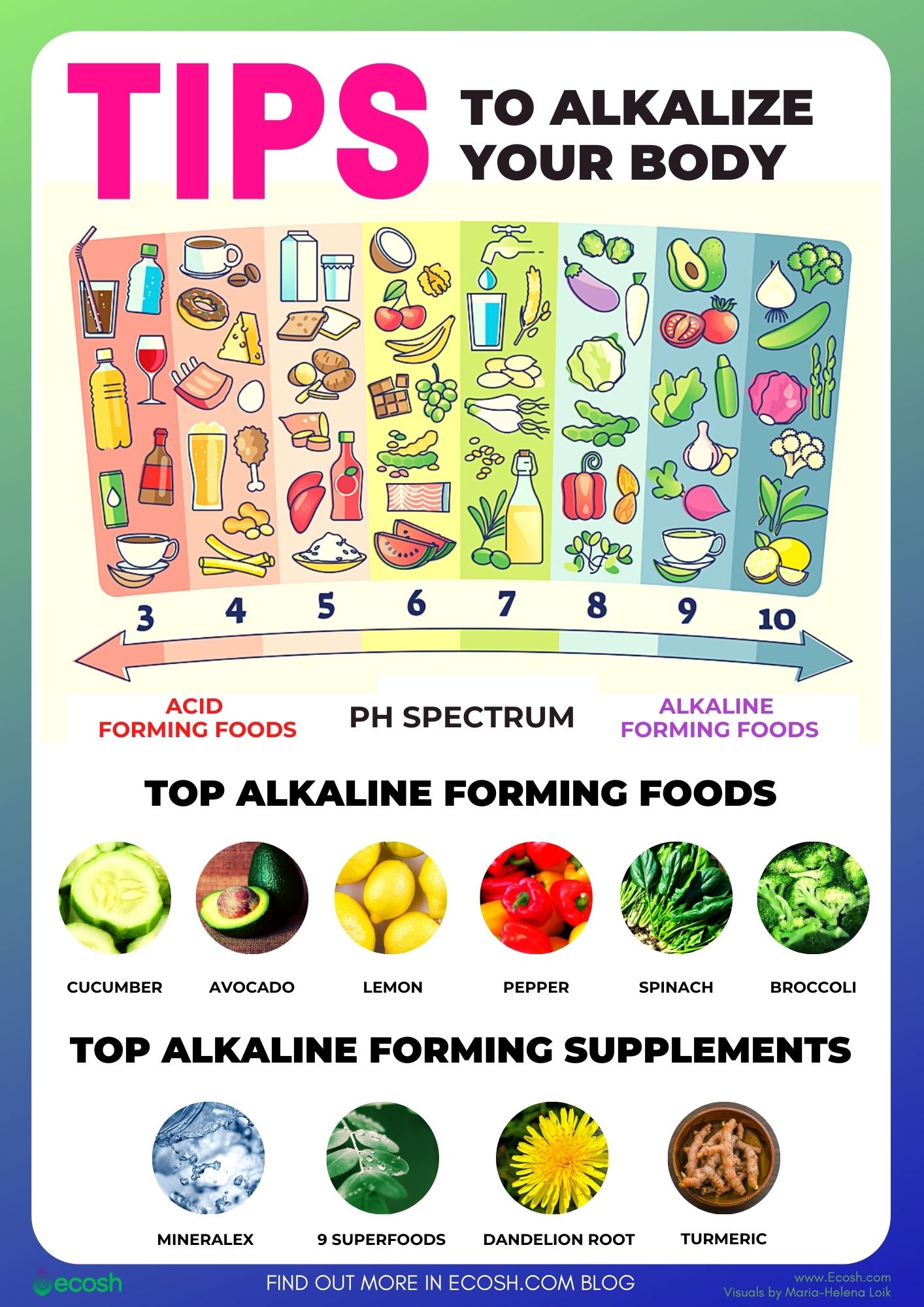Respiratory acidosis occurs when there is too much CO2 (carbon dioxide, which is an acid) in your body, and when your body is unable to remove this excess carbon dioxide through breathing. Respiratory acidosis is sometimes also called hypercapnic acidosis and carbon dioxide acidosis.
For optimal health, your body needs to keep a balance between acidity and alkalinity. Interrupting this balance may lead to serious health issues and an overall feeling of ill health. Even more, severe acidosis can be fatal without treatment.
Normally, the kidneys and lungs can get rid of excess acid in your body. However, an unhealthy diet, some lifestyle habits, certain health conditions, and prescription drugs may increase the risk of having too much acid in your body and finally lead to severe acidosis. Symptoms of respiratory acidosis may include headaches, sleeping problems, difficulty breathing, fatigue, anxiety, tremors, and more.
Eating more alkaline foods or taking certain supplements can help balance acidity in your body, but in some cases medications are needed. Here in this article, we discuss the symptoms, causes, risk factors, complications, and some treatment options of respiratory acidosis (1, 3).

How to Know if You Have Too Much Acid in Your Body – What is pH and What Does The pH Scale Measure
When discussing balancing the acidity levels in your body, it’s firstly important to understand pH, as the acidity and alkalinity are measured by the pH scale. Overall, everything below 7.0 is acidic, and everything above 7.0 is alkaline. The pH value ranges from 0–14:
- 0.0–6.9: Acidic
- 7.0: Neutral
- 7.1–14.0: Alkaline (basic)
The perfect pH range for the human body is considered to be between 6.0 and 6.8. However, it’s important to note that pH differs significantly within your body. While certain parts of your body are alkaline, others are acidic. For example:
- Stomach: Due to hydrochloric acid (that is necessary to break down food), your stomach is highly acidic, as the pH is 2–3.5.
- Blood: On the contrary, your blood is always slightly alkaline, as the pH values range from 7.36 to 7.44.
- Urine: Normally, your urine pH values may range from 4.6 to 8.0. However, the normal value ranges may differ a bit between laboratories, so you should discuss with your provider the meaning of your specific test results (6, 13, 14, 15).
Testing Your PH Levels at Home
One way to measure your pH value (the level of acid in the body) at home is to test your urine. To do this, you can use a simple PH test strip. For best test accuracy, you should perform the test first thing in the morning. However, some suggest testing the second urine of the day, as the first pee will be too acidic (because it dumps the wastes from the night before).
Urine test pH levels
- Lower than 6.5: Your body is considered acidic
- Between 6.5 and 7.5: These are optimal pH levels
- Higher than 7.5: Your body is considered alkaline (13, 15).
Types of Acidosis
The kidneys and lungs maintain the balance (proper pH level) of chemicals called acids and bases in the body. Acidosis occurs when acid builds up or when bicarbonate (a base) is lost and is classified as metabolic or respiratory acidosis.
- Metabolic acidosis. Metabolic acidosis usually happens when your body stores or produces too much acid, when the kidneys are not able to remove this excess acid from the body or there is a loss of bicarbonate from your bloodstream.
- Respiratory acidosis. This type of acidosis occurs when there is too much CO2 (carbon dioxide, which is an acid) in your body, and when your body is unable to remove this excess carbon dioxide through breathing. Respiratory acidosis is sometimes also called hypercapnic acidosis and carbon dioxide acidosis (1).

Causes of Respiratory Acidosis
Respiratory acidosis (also hypercapnic acidosis and carbon dioxide acidosis) occurs when your body is unable to remove excess carbon dioxide (CO2), which then builds up in the body and increases acid levels in the blood. Ordinarily, the lungs remove carbon dioxide during breathing. But, sometimes your body can’t lose the excess CO2.
Causes That May Lead to Respiratory Acidosis Include For Example:
- Chronic airway problems or long-term lung disorders such as asthma, chronic obstructive pulmonary disease (COPD), emphysema, or pneumonia.
- Stroke.
- Chest injury, deformed chest structure (such as kyphosis), or muscle weakness in the chest.
- Obesity, as it can interfere with the expansion of the lungs and make breathing difficult.
- Sedative drugs misuse.
- Alcohol overuse.
- Obstructed airways (due to choking or other causes).
- Nervous system problems.
- The use of drugs that influence the central nervous system, like opioids.
- Conditions that influence the muscles involved in breathing, such as Guillain-Barre syndrome or muscular dystrophy.
- Acute pulmonary edema.
- Scoliosis.
- Cardiac arrest.
- Muscle weakness or other conditions that influence breathing or taking a deep breath.
- In addition, neuromuscular conditions such as myasthenia gravis, muscular dystrophy, or multiple sclerosis (1, 2, 6, 10).

Respiratory Acidosis Symptoms
The symptoms of respiratory acidosis can depend on the underlying cause, but some common symptoms may include:
- Headaches
- Wheezing
- Fatigue and becoming tired easily
- Drowsiness
- Difficulty breathing and/or shortness of breath
- Anxiety
- Sweating
- Sleepiness and sleep problems
- A blue tinge to the skin caused by a low level of oxygen in the blood
- Confusion
- Lethargy
- Seizures
- Coma
- Psychosis
- Tremors (shaking muscle movements)
- Asterixis (irregular lapses of the posture of various body parts)
- Warm and flushed skin (2, 17).
Respiratory Acidosis Risk Factors and Risk Groups
Some factors may increase the risk of developing respiratory acidosis. These risk factors include for instance:
- Asthma
- Having a surgery
- End-stage COPD
- Smoking
- In addition, the use of opioids (2).
Respiratory Acidosis Complications
Respiratory acidosis may lead to complications such as:
- Poor organ function.
- Respiratory failure. Seek immediate medical help if you have a sudden difficulty in breathing or if your airway is obstructed.
- Shock.
- Neurologic complications such as seizure and loss of consciousness.
- In addition, cardiovascular complications (11).
Respiratory Acidosis Prevention
Although you can’t completely prevent respiratory acidosis, there are some things you can do to reduce your risk of developing the condition. Here’s what you can do:
- Do not smoke, as it can harm your lungs and make breathing less efficient.
- Never mix sedatives with alcohol.
- Stay at a healthy weight, as being overweight can affect your breathing (6).

Respiratory Acidosis Treatment
Treatment for respiratory acidosis will depend on the cause, as you must first treat the underlying condition, but the goal is likely to make breathing easier. Some treatment methods include for example:
- Antibiotics (for infection).
- Diuretics (for reducing excess fluid that affects the lungs and heart).
- Bronchodilators (for expanding the airways and relaxing the muscles that play a role in breathing).
- Corticosteroids (for reducing inflammation).
- ADVanced Organ Support (ADVOS) system (enhanced renal support therapy based on albumin dialysis).
- Detoxification (if acidosis is caused by alcohol or drug poisoning, it is treated with detoxification, or in severe cases sometimes also with hemodialysis).
- Hemodialysis (dialysis is the treatment for severe kidney problems or kidney failure that helps to remove wastes and excess acids from the blood).
- Inotropes and other medications (if your acidosis is caused by a heart problem, inotropes and other medications may help to improve heart function in conditions like heart failure and low blood pressure. These treatments improve oxygen flow to your body and lower blood acid levels).
- In addition, mechanical ventilation (used only in severe cases) (2, 6, 10, 16, 18).
How To Naturally Alkalize Your Body
1. Stay Hydrated
2. Sodium Bicarbonate Or Sodium Citrate Pills
Bicarbonate (a form of carbon dioxide) is an alkaline (the opposite of an acid), and may therefore help balance the acid in the blood, as well as help prevent kidney disease from getting worse. Intravenous (IV) treatment with sodium bicarbonate is used to treat conditions that cause acidosis through bicarbonate (base) loss. This can occur due to diarrhea, some kidney conditions, and vomiting. However, do not attempt this type of treatment without the supervision of a doctor.
3. Supplements
Certain supplements may help balance the acidity and fight inflammation in your body if your metabolic acidosis is caused by an unhealthy diet. These supplements include for example:
- 9 SUPERFOODS SUPER GREEN – The best acid-base balancers in the body are green plants that also contain minerals such as magnesium, sodium, potassium, calcium, and so on. These all green medicinal forest plants are also contained in 9 SuperFoods. This supplement is rich in nutrients and has a high alkaline grade. 9 SuperFoods provides perfect support for the overall condition of the body and its digestive functioning while contributing to cleansing the body and supporting the immune system.
- MINERALEX SEA WATER – The benefits of salts and soda are well-known when it comes to alkalizing the body. Purified seawater is also extremely high in minerals. Natural seawater in the Mineralex includes more than 70 minerals and trace elements, with the highest concentration of magnesium, sodium, and potassium. These minerals that are fast-absorbing help to keep the body alkaline, provide energy for organs, tissues, and bones, and participate in producing body fluids and enzymes.
- DANDELION and TURMERIC – These anti-inflammatory plants help to reduce inflammation in your body and provide plenty of minerals that also help to eliminate pathological microorganisms such as viruses, fungi, parasites, and harmful bacteria.
4. Healthy Diet
Acidosis that is caused by an unhealthy diet (diet-induced metabolic acidosis) can be reversed with more alkaline-forming foods. A diet that contains mostly plant-based protein, and plenty of fruit and vegetables (as fruit and vegetables can increase alkaline levels in your body) instead of animal protein can help prevent acid levels from climbing too high in the body. Alkaline forming foods include foods such as:
- Honey
- Raisins
- Corn
- Avocados
- Spinach
- Celery
- Cucumber
- Broccoli
- Pepper
- Figs
- Fresh fruits
- Fresh vegetables
- Soy products
- Coconut
- Molasses
- Lemon water. For instance, some suggest drinking lemon water every morning. You can make it by pressing the juice of half of the lemon with one cup of water (2, 3, 6, 9, 12).
NB! The information provided here is for informational purposes only, so do not consider it as health care or medical diagnosis and treatment. Do not consider this information as a guarantee of the results you want to achieve. In addition, do not take this information as a replacement for the advice of your physician or other healthcare professional.
Even more, you should not use it to diagnose or treat a health problem. Before changing or discontinuing your existing medication, treatment, or care, or taking any dietary supplements, be sure to consult with your healthcare professional or doctor before starting any diet or program, or if you suspect you may have a medical condition.
Written by Maria-Helena Loik
Pictures: Pexels.com, Pixabay.com, Shutterstock.com
Sources:
- Acidosis: MedlinePlus Medical Encyclopedia
- Acidosis: Types, symptoms, complications, and treatment (medicalnewstoday.com)
- Signs of Poor pH Balance in the Body (livestrong.com)
- Metabolic acidosis – Wikipedia
- High Anion Gap Metabolic Acidosis – StatPearls – NCBI Bookshelf (nih.gov)
- Acidosis: Symptoms, Causes, and Treatment for Blood pH Levels (healthline.com)
- Metabolic Acidosis | National Kidney Foundation
- Examining the relationship between diet-induced acidosis and cancer (nih.gov)
- Metabolic acidosis – symptoms, complications & treatment – American Kidney Fund (AKF)
- Respiratory Acidosis: Types, Symptoms, and Causes (healthline.com)
- Respiratory acidosis (patient information) – wikidoc
- Dietary Treatment of Metabolic Acidosis in Chronic Kidney Disease (nih.gov)
- Are You Acidic or Alkaline? – Rose Wellness
- Acid-Base Homeostasis (nih.gov)
- Urine pH test (ucsfhealth.org)
- Symptoms of Acidosis and Natural Treatment Options (water-for-health.co.uk)
- Respiratory Acidosis: Symptoms, Causes, Diagnosis, Treatment, and Coping (verywellhealth.com)
- Respiratory and metabolic acidosis correction with the ADVanced Organ Support system (nih.gov)


